
DCMIX-4
A new round of the SODI-DCMIX experiment is coming up on the first half of 2018. The scientific objective is the determination of the diffusion coefficients of ternary fluid mixture samples, same as in previous DCMIX experiments, but this time instead of having just one mixture with diverse concentrations, three ternary mixtures will be observed under different conditions. The importance of the results obtained with the DCMIX2 experiment has led to the inclusion of three sample cells with Toluene-Methanol-Cyclohexane, which is the same mixture used in the former experiment. The new concentration mixtures covers some interesting zones already not studied and will complement the previous results. Polystyrene-Toluene-Hexane sample cell will be accompanied by a binary mixture cell of Polystyrene-Toluene; the behaviour of this mixture is expected to provide an easy to analyze and interpret scientific data. Last but not least, this will be the first time the thermal and mass diffusion coefficients for a ternary nanofluid mixture are studied in microgravity, with the use of one sample cell of Tetrahydronaphthalene-Toluene-Fullerene mixture.
The experiment setup will be the same as in previous DCMIX experiments, with Microgravity Science Glovebox (MSG) providing resources to the main SODI hardware, which remains on orbit, and that is used to process the new DCMIX cell array that will be uploaded to the ISS. A new item in MSG, the MSG removable window, will make the installation activities easier for the crew, facilitating the installation of SODI inside the work volume.




